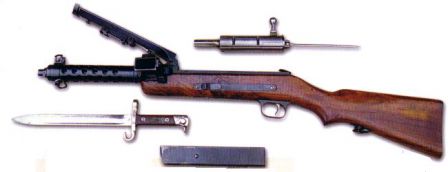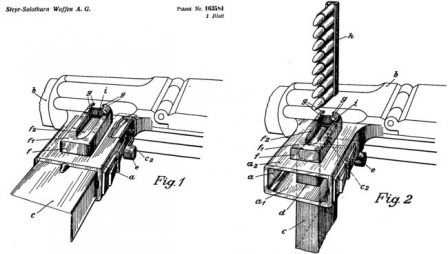Steyr MP-34 submachine gun, left side.
Steyr MP-34 submachine gun, right side.
Steyr MP-34 partially disassembled.
Drawing from original patent, covering S1-100 integral magazine loading device.
| Caliber | 9x19mm Luger / Parabellum, 9x23 Steyr, 9x25 Mauser Export |
| Weight | 4,25 kg empty |
| Length | 850 mm |
| Barrel length | 200 mm |
| Rate of fire | 400-500 rounds per minute |
| Magazine capacity | 32 rounds |
| Effective range | 150-200 meters |
The story of this weapon start in around 1919, when German arms-making
company Rheinmetall produced a prototype submachine gun designated
MP.19. This weapon was developed by Lous Stange to same specifications
as Schmeisser'sMP.18/I, but MP.19 came too late
to see any action during WW1. After the end of WW1, Germany was
severely limited in design and production of small arms by treaty of Versailles.
When Hitler came into power, German military-oriented companies began
to move the R&D outside of Germany to avoid treaty limitations. In
1929, Rheinmetall purchased the small Swiss-based company Wafenfabrik
Solothurn, which was used to finalize some Rheinmetall small arms which
were developed under secrecy in Germany. One of those weapons
was an improved version of MP.19 submachine gun, which was announced by
Waffenfabrik Solothurn under company index "S1-100". This was an
excellent weapon, reliable, controllable and accurate, but Solothurn
company lacked production capabilities. To make guns on industrial
scale, Solothurn teamed with famous Austrian gun-making company
Waffenfabrik Steyr, and formed trade company Steyr-Solothurn Waffen AG
in Zurich, Switzerland. This company sold weapons designed by
Rheinmetall and Solothurn and made by Steyr, and S1-100 submachine gun
was among first products of this international conglomerated. In the
1930 Austrian police adopts the S1-100 as Steyr MP.30, chambered for
standard Austrian 9x23 Steyr pistol cartridge. It was also exported to
Chile, Bolivia, Uruguay and El Salvador; it also was sold in limited
numbers to China, in 7,63x25 Mauser caliber. Portugal adopted the S1-100
in 7,65x22 Luger caliber in 1938, and in 1942 purchased more S1-100's
from Steyr but this time in 9x19 Luger. For South American markets,
Steyr produced version of S1-100 in .45ACP caliber; this version was
distinguished by additional pistol grip under the forearm. Austrian army
adopted the S1-100 as Steyr MP.34, chambered for powerful 9x25 Mauser
ammunition. When Hitler's Germany occupied Austria in 1938, it quickly
consumed most of Austrian MP.30's and MP.34's, and after rebarreling to
9x19 ammunition these weapons were issued to German troops as MP.34(ö).
Production of Steyr-Solothurn submachine guns has ceased in around 1940,
when, under German administration, it was replaced in production at
Steyr by much simpler and less expensive MP-40 submachine gun of
German design. It must be noted that S1-100 was one of the finest
submachine guns made prior to WW2, and probably one of most expensive.
Steyr-Solothurn S1-100 submachine gun was blowback operated,
selective-fired weapon which fired from open bolt. Unlike most other
submachine guns, the return spring was located in the buttstock and was
linked to bolt via long push-rod, pivotally attached to the rear of the
bolt. The basic action of the gun was accessible through the top cover,
which was hinged at the front and opened up and forward to expose bolt
and trigger unit below it. The fire mode selector was made in the form
of a sliding switch, located at the left side of the stock. Early guns
had Schmeisser-style bolt-locking safety in the form of hook-shaped cut
which was used to engage the bolt handle when bolt was cocked. Later on,
additional manual safety was added to the top cover, in front of the
rear sight. this safety locked bolt either in cocked or closed position.
The feed was from left side, with magazine housing slightly canted
forward for more positive feeding Ejection was to the right. The
magazine housing had an unusual magazine filler
device, with slots for magazine at the bottom and for stripper clip -
at the top. removed magazine was inserted into this device from the
bottom, and then shooter placed stripper clips into the top of device
and pushed cartridges down into magazine. Four standard 8-round clips
were required to fill the magazine.
All S1-100 guns were fitted with wooden stock with semi-pistol grip. Barrel was enclosed into perforated jacket, which had provisions for mounting a bayonet. Sights included hooded front and tangent type rear, marked from 100 to 500 meters. One most unusual accessory, which was briefly advertised for S1-100 during mid-1930s, was a compact machine-gun type tripod, which was to provide additional stability for weapon when firing from ground. It seems that this tripod was never made in quantity.
All S1-100 guns were fitted with wooden stock with semi-pistol grip. Barrel was enclosed into perforated jacket, which had provisions for mounting a bayonet. Sights included hooded front and tangent type rear, marked from 100 to 500 meters. One most unusual accessory, which was briefly advertised for S1-100 during mid-1930s, was a compact machine-gun type tripod, which was to provide additional stability for weapon when firing from ground. It seems that this tripod was never made in quantity.


 09.20
09.20
 Jack The Ripper
Jack The Ripper





 Posted in:
Posted in:
0 komentar:
Posting Komentar